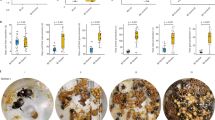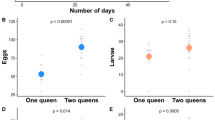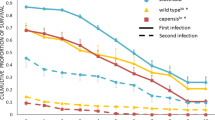Abstract
IN most species of social Hymenoptera with queen–worker dimorphism, workers cannot mate but retain functional ovaries1; because males arise from unfertilized haploid eggs, workers can potentially produce males. Worker-derived males are frequent in some species, but in others occur only in queenless colonies2,3. Workers are more related to their own sons (coefficient of 0.5) than to the queen's sons (their brothers; 0.25); they are also more related to nephews (0.375) than brothers if queens mate with one male, but if queens mate with more than two unrelated males a worker's mean rela tedness to nephews is less than to brothers3–5. In this case workers could benefit by 'worker policing'3,5: prevent-ing each other from producing males, perhaps by destroying worker-laid eggs or by aggression toward reproductive workers. Worker reproduction is rare in queenright colonies of species with multiply mated queens (such as honeybees6 and some yellowjacket wasps7), but is common in some monandrous species (bumblebees and stingless bees3). Here we describe experiments showing strong discrimination by honeybee (Apis mellifera) workers against worker-laid male eggs, supporting the worker-policing hypothesis. The honeybee was studied because queens mate with 10–20 males8, making worker policing seem likely as a cause for the rarity of worker-derived males (about one in a thousand males is worker-derived6).
This is a preview of subscription content, access via your institution
Access options
Subscribe to this journal
Receive 51 print issues and online access
$199.00 per year
only $3.90 per issue
Buy this article
- Purchase on Springer Link
- Instant access to full article PDF
Prices may be subject to local taxes which are calculated during checkout
Similar content being viewed by others
References
Oster, G. F. & Wilson, E. O. Caste and Ecology in the Social Insects. (Princeton University Press, 1978).
Bourke, A. F. G. Q. Rev. Biol. 63, 291–311 (1988).
Ratnieks, F. L. W. Am. Nat. 132, 217–236 (1988).
Hamilton, W. D. Ann. Rev. Ecol. Syst. 3, 193–232 (1972).
Starr, C. K. 1984 in Sperm competition and the evolution of animal mating systems. (ed. Smith, R. L.) 428–459 (Academic, Orlando, Florida, 1984).
Visscher, P. K. Behav. Ecol. Sociobiol. 25, 247–254 (1989).
Ross, K. G. Nature 323, 798–800 (1986).
Page, R. E. Ann. Rev. Entomol. 31, 297–320 (1986).
Taber, S. J. Econ. Entomol. 54, 247–250 (1961).
Visscher, P. K. Behav. Ecol. Sociobiol. 18, 453–460 (1986).
Page, R. E. & Erickson, E. H. Behav. Ecol. Sociobiol. 23, 117–126 (1988).
Laidlaw, H. H. Contemporary Queen Rearing (Dadant. Hamilton, Illinois, 1979).
Ratnieks, F. L. W. thesis, Cornell Univ. (1989).
Lloyd, J. E. Ann. Rev. Entomol. 28, 131–160 (1983).
Trivers, R. L. & Hare, H. Science 191, 249–263 (1976).
Author information
Authors and Affiliations
Rights and permissions
About this article
Cite this article
Ratnieks, F., Visscher, P. Worker policing in the honeybee. Nature 342, 796–797 (1989). https://doi.org/10.1038/342796a0
Received:
Accepted:
Issue Date:
DOI: https://doi.org/10.1038/342796a0
This article is cited by
-
Functional properties of ant queen pheromones as revealed by behavioral experiments
Behavioral Ecology and Sociobiology (2023)
-
Chemical signatures of egg maternity and Dufour’s gland in Vespine wasps
The Science of Nature (2023)
-
Conserved worker policing in African carpenter ants with drastically different egg chemotypes
Evolutionary Ecology (2023)
-
The effect of the brood and the queen on early gene expression in bumble bee workers' brains
Scientific Reports (2022)
-
Similarities in Recognition Cues Lead to the Infiltration of Non-Nestmates in an Ant Species
Journal of Chemical Ecology (2022)
Comments
By submitting a comment you agree to abide by our Terms and Community Guidelines. If you find something abusive or that does not comply with our terms or guidelines please flag it as inappropriate.



